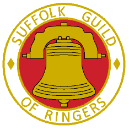Sunday 7th December 2025
History of Ringing in Suffolk -
up to 1990
All Years
- News Archive (1991 onwards)
- Guild History (George Pipe & Rowan Wilson)
- Guild Magazines - Awl a'huld, Spring 2010 - Summer 2017 (23 issues).
- Guild Annual Reports - 1923 onwards.
- Newspaper clippings - 1725 onwards.
- Norwich
Diocesan Association of Ringers Annual Reports - 1877 on with gaps.
For historic information on ringers and ringing in the Eastern half of Suffolk prior to the Guild's formation in 1923. - Striking Competitions results
- The history of bellringers & bellringing - CCCBR history website
1974
1973
- Suffolk Guild 50th Anniversary edition of The Ringing World - 6th April
- 162 quarter peals rung to mark the 50th Anniversary
1972
- Interview with Ernest Ambrose at Lavenham - November
1965
- NW District Annual Meeting - Richy's Blog 17/10/2025
1940
- Bowell of Ipswich, 1870-1940 in the Suffolk Record Office (Ipswich Branch)
1932
- Debenham Bells (Searchable pages from The Ringing World)
1920s
- Photo of Bildeston handbell ringers in 1920 (by kind permission of Katharine Salter).
1910
- Some Particulars of the Principal Rings of Bells in the Eastern Counties, Rev William C Pearson (Suffolk towers only)
1899
1865
- * Samuel Slater of Glemsford
ringing records book (1865 - 1908)
* 355MB file - very slow to load for viewing.
1828
- Asa Hayward's peal book (1827 - 1828)
1822
- The Conductor or Bob Major in Miniature John Elmer's MS book
1815
- Annuals of Stowmarket Ringing (1815 - 1850) John Elmer's MS book
1779
c1750
1640
- * History of ringing in
Suffolk (1640 - 1908) by Samuel Slater of Glemsford
* 266MB file - very slow to load for viewing.
